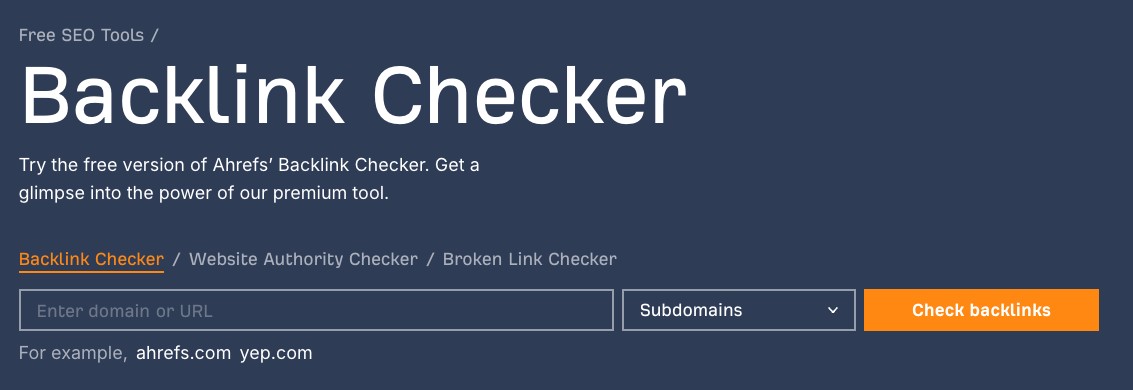Key Attributes Of A "Good" Backlink
The quality of a backlink depends on several critical factors. These include how relevant the linking site is to your content, the authority of the domain, where the link appears on the page, what type of link attributes it carries, and the anchor text used.
Relevance
Relevance is the backbone of quality backlinks. If you run a pizza restaurant and get a backlink from a knitting blog, search engines scratch their digital heads in confusion.
A relevant backlink comes from a domain that shares topical similarity with your content. When a fitness website links to your gym equipment review, that's relevance gold.
Industry relevance matters more than you might think. A backlink from a competitor or complementary business carries significantly more weight than random links.
If you sell running shoes, a link from a marathon training blog beats one from a cat grooming service every time.
Key relevance factors:
- Topical alignment between linking and target pages
- Industry connection between domains
- Content context surrounding the link
- User intent match for both audiences
Authority
Domain authority acts like a credibility score in the backlink world. Getting linked by CNN feels different than getting mentioned by your neighbor's blog that gets three visitors per month.
High authority domains have established trust with search engines through consistent quality content and strong backlink profiles. These sites typically have higher domain authority scores and pass more link juice to your pages.
You can check domain authority using tools like Moz, which scores domains from 1 to 100. Websites with scores above 50 generally carry more SEO weight.
For a quick and free way to check backlinks and get a glimpse into a website's backlink profile, you can also use the Ahrefs Free Backlink Checker. Simply visit ahrefs backlink checker

enter the domain or URL, and click 'Check backlinks' to see a snapshot of its referring domains, anchor texts, and more.
However, don't ignore smaller, niche-relevant sites. They can still provide valuable ranking signals.
Authority indicators include:
- Domain authority scores (Moz metric)
- Age and history of the domain
- Quality of the site's own backlink profile
- Consistent publishing of quality content
- Traffic volume and user engagement
Prominence And Placement
Links within the main content body carry the most weight. When your link appears naturally within a paragraph discussing relevant topics, search engines view this as editorial endorsement.
Header sections and sidebar links hold moderate value. Footer links, comment sections, and author bios typically pass less link juice.
While these aren't worthless, they shouldn't form the backbone of your link building strategy.
Prime link locations:
- Within main content - highest value
- Resource pages - strong editorial signals
- Navigation menus - moderate authority
- Sidebar sections - limited impact
- Footer areas - minimal SEO benefit
Link Attributes (Rel Tags)
Link attributes tell search engines how to treat specific backlinks. The most important distinction lies between dofollow links and nofollow links, though several other attributes exist.
Dofollow links pass link juice and ranking authority to your pages. These represent the gold standard for SEO backlinks.
When no rel attribute appears in the link code, it defaults to dofollow status. Nofollow links include the rel="nofollow" attribute, instructing search engines not to follow the link for ranking purposes.
While these don't directly boost rankings, they still drive traffic and provide brand exposure.
Common link attributes:
- No attribute (dofollow) - passes full SEO value
- rel="nofollow" - blocks link juice transfer
- rel="sponsored" - identifies paid links
- rel="ugc" - marks user-generated content links
Google introduced sponsored and ugc attributes to help webmasters properly categorize different link types while avoiding potential penalties for toxic links.
Anchor Text
Anchor text serves as the clickable text portion of your backlink. This text provides context clues to search engines about your target page content, making it a crucial ranking factor.
Natural anchor text distribution includes your brand name, exact keywords, partial keywords, and generic phrases like "click here." Over-optimization with exact match keywords can trigger spam filters and hurt your rankings.
The best anchor text profiles look organic and varied. Mix branded anchors (your company name), topical keywords, and natural phrases.
Avoid repetitive exact-match keywords that scream manipulation to search engines.
Healthy anchor text types:
- Branded anchors (40-50%) - your company name
- Partial match (20-30%) - variations of target keywords
- Exact match (5-10%) - precise target keywords
- Generic phrases (10-20%) - "read more," "this article"
- URLs (5-10%) - naked links to your domain
Remember that anchor text optimization works best when it appears natural within the surrounding content context.
Google's Approach To Link Evaluation

Google treats backlinks like a popularity contest, but one where quality trumps quantity every time. The search engine uses sophisticated algorithms to evaluate each inbound link pointing to your site.
Think of it as having a very picky bouncer at an exclusive club. Domain authority and referring domain strength play major roles in this evaluation process.
Google examines the source of each link to determine if it's worth passing along ranking power. A single quality backlink from a high-authority site beats dozens of links from sketchy sources.
The search giant looks at several key factors when assessing your backlinks:
| Factor | What Google Checks | Impact on Rankings |
|---|---|---|
| Authority Score | DR score and domain strength | High |
| Relevance | Topic alignment | Very High |
| Link Context | Surrounding content quality | Medium |
| Anchor Text | Natural vs. over-optimized | High |
Google's algorithms can spot link farms and manipulative schemes from miles away. These low-quality referring domains actually hurt your search rankings instead of helping them.
The search engine prefers natural linking patterns that indicate genuine endorsement. Referral traffic also signals link quality to Google.
Links that send engaged visitors to your site carry more weight than those that generate zero clicks. This creates a feedback loop where valuable content attracts quality backlinks naturally.
Practical Application For Link Building
When you start checking backlink quality, you're basically becoming a detective in the digital world. The good news is you don't need a magnifying glass or a trench coat.
Start with a backlink audit to see what links currently point to your site. This gives you a baseline for your link building efforts.
Think of it as taking inventory before you go shopping for more links. Use tools like Ahrefs or Semrush to analyze your backlink profile.
These platforms show you which domains link to you and their authority scores. Look for link building opportunities by studying competitors' backlinks.
If they got a link from a quality site, chances are you can too. It's like following breadcrumbs, but way more profitable.
Key metrics to track during link building:
| Metric | What It Shows | Why It Matters |
|---|---|---|
| Domain Authority | Site strength | Higher = better link juice |
| Anchor Text | Link context | Natural variety looks good |
| Referring Domain | Number of linking sites | More domains = better |
Monitor your backlink report regularly to spot new links and lost ones. This helps you understand which link building strategies work best.
You can catch problems early before they hurt your ranking. Focus on removing low-quality backlinks that might drag down your profile.
Frequently Asked Questions
What's the secret sauce for measuring if a backlink is from Zeus or just a mere mortal?
The divine backlinks come from high domain authority sites that pack serious SEO punch. You want to look for referring domains with strong metrics in tools like Ahrefs, Semrush, or Moz.
Check if the linking domain has real organic traffic flowing through it. A website that attracts actual visitors is worth more than a ghost town with fancy domain authority numbers.
The quality of the linked page matters too. Evaluating backlink quality means checking if the content is relevant and well-written, not just keyword stuffed nonsense.
In the battle of quality vs. quantity, how can I tell if a backlink is worth its weight in gold?
One golden backlink beats a hundred bronze ones every time. Focus on the relevance between your site and the linking domain - search engines love when topics match up naturally.
Look at the anchor text being used in the link. Natural, diverse anchor text patterns signal quality, while over-optimized keyword stuffing screams spam to search engines.
The linking page's content quality tells the whole story. High-quality websites publish valuable content that actually helps readers, not thin articles designed just for link juice.
Can I get a backstage pass to understanding why some backlinks get the VIP treatment?
VIP backlinks come from trusted websites in your industry or niche. These referring domains have earned their ranking through consistent quality content and legitimate SEO practices.
Editorial links within relevant content get the red carpet treatment. When someone naturally mentions your site in an article, that carries way more weight than directory listings.
Google's algorithm gives bonus points to backlinks from sites that rarely link out. When a selective website chooses to link to you, it's like getting an endorsement from a celebrity.
Are there sparkly telltale signs that a backlink is as valuable as a unicorn frappuccino?
The sparkle comes from contextual placement within quality content. Links buried in footers or sidebars don't shine as bright as those woven naturally into article text.
Traffic to your website from the backlink is pure gold. Tools that analyze both quality and quantity metrics help you spot links that actually send visitors your way.
Fresh backlinks from active sites sparkle more than dusty old links. Websites that publish regularly and maintain their content give you more valuable link juice.
What are the mystical metrics for deciding if a backlink belongs in the hall of fame or the hall of shame?
Domain authority from Moz gives you a quick snapshot of a site's overall strength. But don't worship this metric alone - combine it with other signals for the full picture.
The number of backlinks pointing to the linking page matters. Pages with their own strong backlink profile pass more authority to your site through their links.
Watch out for red flags like sudden bursts of links from suspicious websites. These patterns often signal spam that belongs in the hall of shame.
How do I play Sherlock Holmes in the mysterious world of backlink sleuthing?
Start your investigation by examining the actual website that's linking to you. The first step in backlink quality analysis involves checking the site's overall trustworthiness and content quality.
Use free backlink checker tools to gather evidence about your suspect links. Multiple data sources help you build a complete case file on each backlink's true value.
Cross-reference the linking domain's metrics across different SEO tools. When Ahrefs, Semrush, and other platforms tell the same story, you've cracked the case.